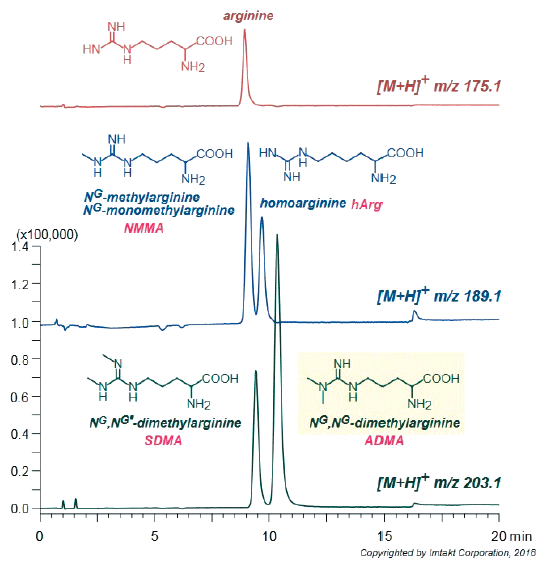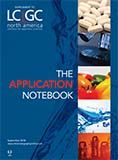Novel Stationary Phase Aids in the Fight Against Cardiovascular Disease
The Application Notebook
Elevated ADMA, SDMA and NMMA are early biomarkers for cardiovascular disease. LC–MS methods are challenging due to the high similarity of these compounds, often requiring derivatization. Here we show successful non-derivatized LC–MS separation of these and other related compounds, on a novel stationary phase.
Factors leading to the reduction of nitric oxide (NO) production, such as an increase in asymmetric and symmetric dimethyl-arginine (ADMA/SDMA) (1,2) and NG-monomethyl-arginine (NMMA) 3,4, as well as a decrease in homoarginine (hArg) 5,6,7, negatively impact endothelial function and promote the development of atherosclerosis. Therefore, early detection of these biomarkers is critical in the fight against cardiovascular disease (CVD).
There are several challenges in developing an LCMS method which can reliably separate these compounds, due to their similarities. For example, ADMA and SDMA are isomers, differing only in the position of two methyl groups, making them difficult to resolve chromatographically using traditional columns and methods. They also share the same mass/charge ratio of 203.1 m/z, meaning that they cannot be distinguished by mass spectrometry alone. NMMA and hArg also share the same m/z of 189.1, adding to the complexity of this analysis.
Current methods rely on complicated derivatizations, making them cumbersome and unreliable. Here, we show an LC–MS method using our Intrada Amino Acid column, which is designed specifically to separate amino acids and similar compounds, without the need for analyte modification.
Experimental Conditions
See Figure 1. Standards were purchased from Sigma Aldrich and tested by LC–MS without derivatization, using the following column and conditions:
Intrada Amino Acid (Imtakt Corp., Kyoto, Japan)
100 × 3 mm (WAA34)
A: 50 mM ammonium formate
B: 100 mM ammonium formate/methanol = 70/30
20–50%B (0–15min), 100%B (15–20 min)
0.5 mL/min (8MPa), 37 °C, 10 µL (0.66–2.4 nmol/mL, 1% formic acid)
Single Quad. MS (ESI, positive)

Figure 1: LC-MS analysis of asymmetric/symmetric dimethylarginines (ADMA/SDMA) and related compounds.
Result and Discussion
ADMA/SDMA were baseline resolved, in just over 10 min, despite being isomers. NMMA and hArg are also well resolved on the Intrada Amino Acid column. Arginine, the common precursor molecule to the other compounds shown, has excellent peak shape in this method, and should be considered in the total characterization of a patient's risk for CVD.
Conclusion
In the laboratory, accurate LCMS testing of these compounds is challenging due to their similarities, and rarely accomplished without derivatization. Here, we show that the novel stationary phase of our Intrada Amino Acid column is able to resolve all of these compounds without any analyte modification, which will likely improve the accuracy and ease for clinical reporting. The simplicity of this analysis is sure to make this method an attractive alternative to current strategies, as a vast improvement to aid in the fight against CVD.
References
(1) E.H. Zobel et al., Cardiovasc Diabetol.16(1), 88 (2017).
(2) I. Lin et al., J Am Soc Hypertens.10(2), 115–123 (2016).
(3) N.M. Olken et al., Biochemistry32(37), 9677–9685 (1993).
(4) R.Shankar et al., J. Clin. Invest.102(7), 1403–1412 (1998).
(5) W.März et al., Circulation. 122(10), 967–975 (2010).
(6) A.A. Kayacelebi et al., Amino Acids 47(9), 1893–1908 (2015).
(7) N. Papageorgiou et al., Amino Acids 47(9), 1741–1750 (2017).

Imtakt USA
2892 NW Upshur St., Portland, OR, 97210
tel. (888) 456-HPLC, (215) 665-8902, fax (501) 646-3497
Website: ImtaktUSA.com














